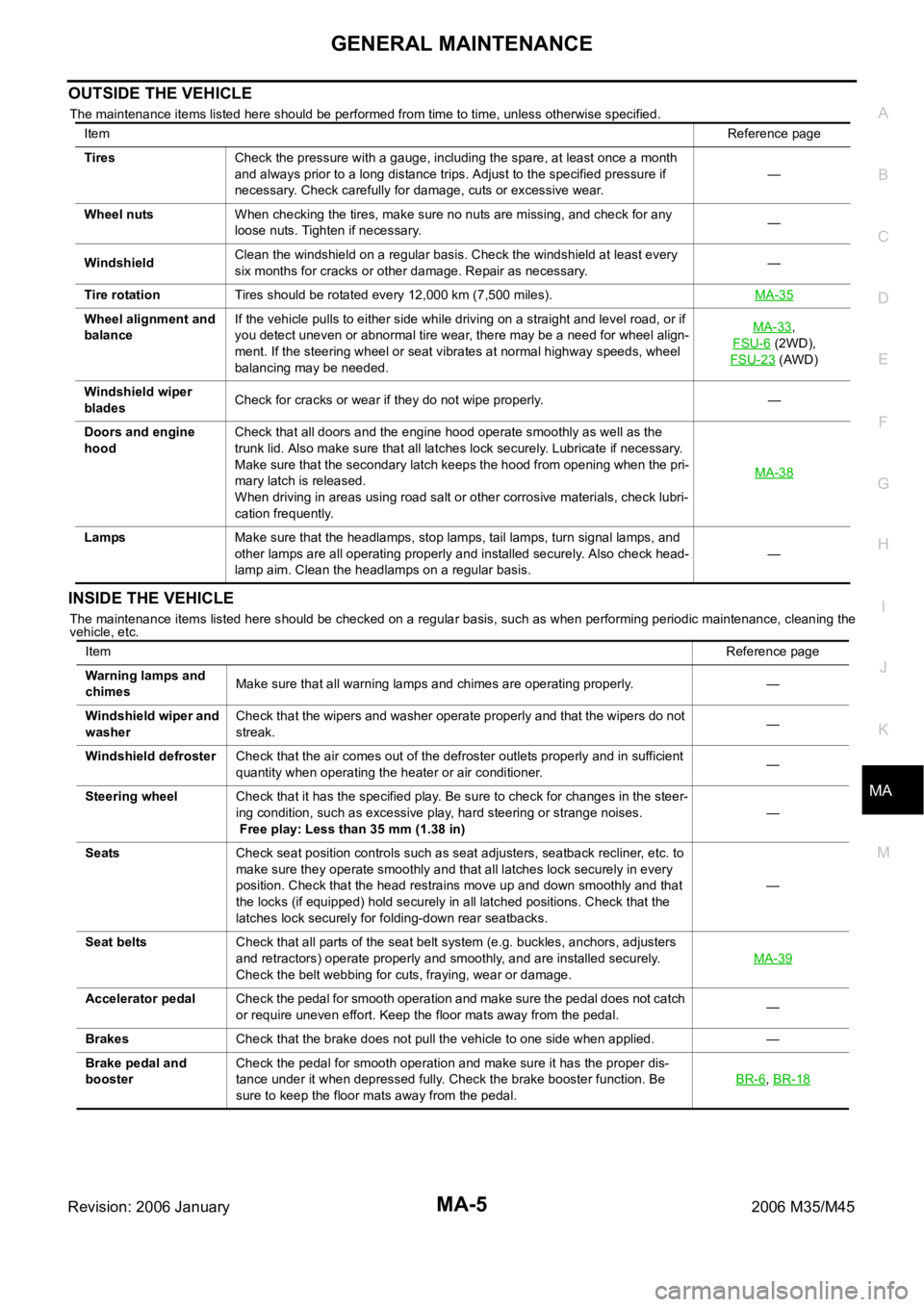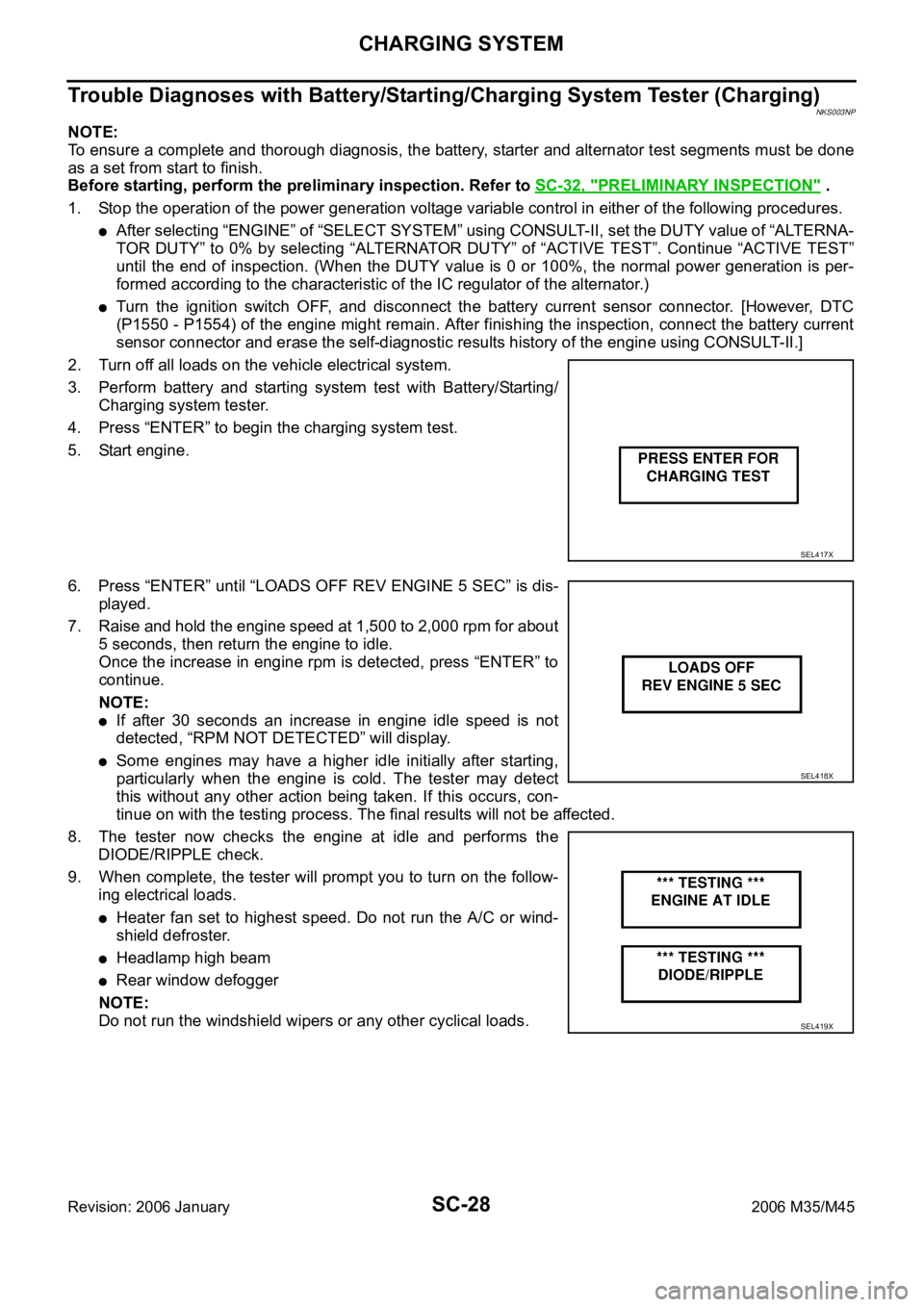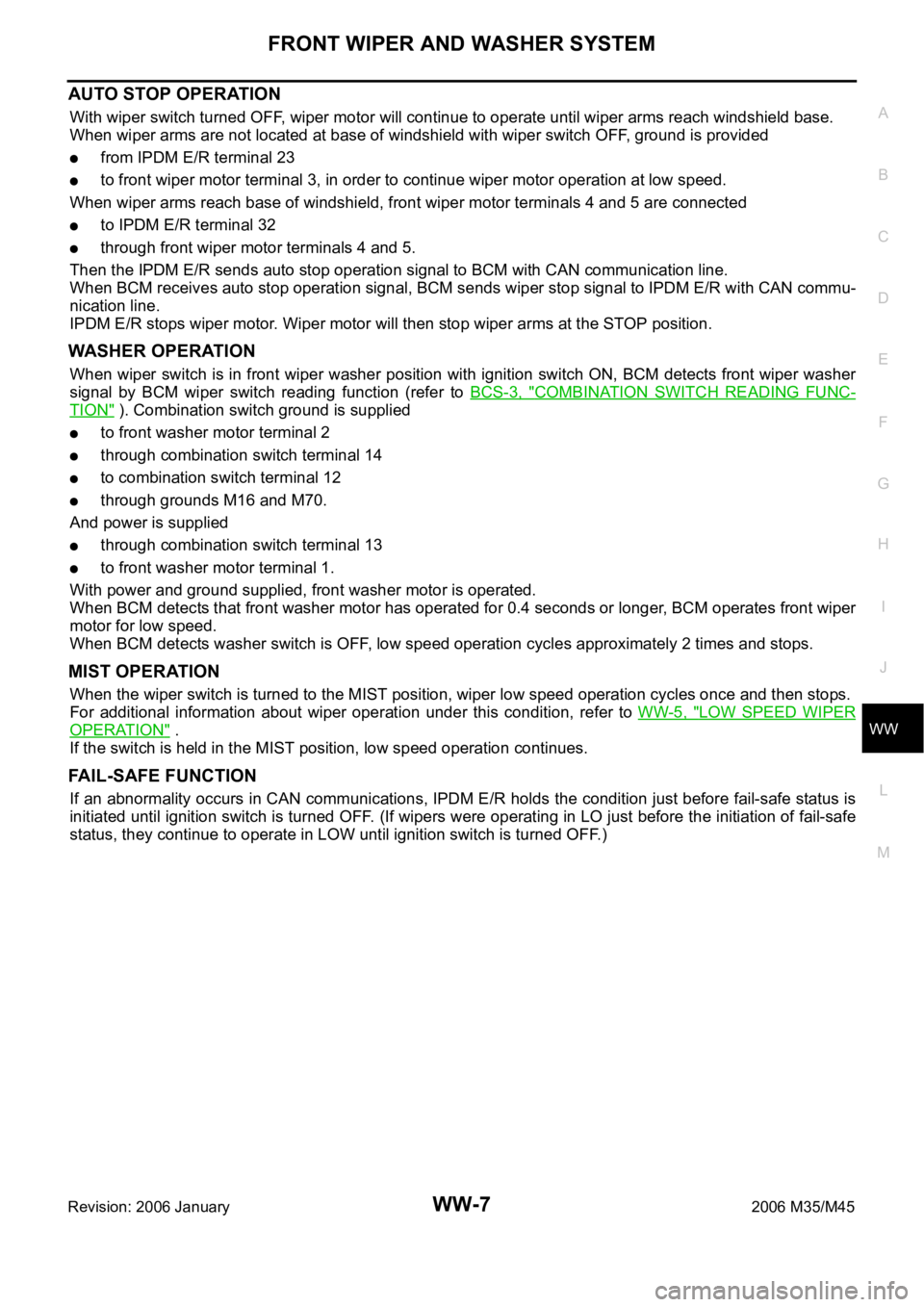2006 INFINITI M35 windshield wipers
[x] Cancel search: windshield wipersPage 39 of 5621
![INFINITI M35 2006 Factory Service Manual ACS-30
[ICC]
TROUBLE DIAGNOSIS - GENERAL DESCRIPTION
Revision: 2006 January2006 M35/M45
Display Item List
Laser Beam Adjust
For details, refer to ACS-13, "LASER BEAM AIMING ADJUSTMENT" .
SELF- INFINITI M35 2006 Factory Service Manual ACS-30
[ICC]
TROUBLE DIAGNOSIS - GENERAL DESCRIPTION
Revision: 2006 January2006 M35/M45
Display Item List
Laser Beam Adjust
For details, refer to ACS-13, "LASER BEAM AIMING ADJUSTMENT" .
SELF-](/manual-img/42/57023/w960_57023-38.png)
ACS-30
[ICC]
TROUBLE DIAGNOSIS - GENERAL DESCRIPTION
Revision: 2006 January2006 M35/M45
Display Item List
Laser Beam Adjust
For details, refer to ACS-13, "LASER BEAM AIMING ADJUSTMENT" .
SELF-DIAGNOSTIC RESULTS
For details, refer to ACS-39, "Diagnostic Trouble Code (DTC) Chart" .
DATA MONITOR
Operation Procedure
1. Touch “DATA MONITOR” on “SELECT DIAG MODE” screen.
2. Touch any of “MAIN SIGNALS” and “SELECTION FROM
MENU” on selection screen.
3. Touch “START”.
4. Display the data monitor.
5. Touch “COPY” to print data if necessary.
Monitored Item
: Applicable Cause of cancellation Description
OPERATING WIPER Windshield wipers were operated at HI or LO speed operation.
OPERATING ABS ABS function was operated.
OPERATING TCS TCS function was operated.
OPERATING VDC VDC function was operated.
OPE SW VOLT CIRC Outside the standard control switch input voltage was detected.
ECM CIRCUIT ECM did not permit ICC operation.
LASER SUN BEAM Intense light such as sunlight entered ICC sensor integrated unit light sensing part.
LASER TEMP Temperature around ICC sensor integrated unit became low.
OP SW DOUBLE TOUCH ICC steering switches were pressed at the same time.
WHL SPD ELEC NOISE Wheel speed sensor signal caught electromagnetic noise.
VDC/TCS OFF SW VDC OFF switch was pressed.
WHEEL SPD UNMATCH Wheel speed became different from A/T vehicle speed.
TIRE SLIP Wheel slipped.
IGN LOW VOLT Power supply voltage became low.
SNOW MODE SW Snow mode switch was pressed.
VHCL SPD DOWN Vehicle speed becomes 20 MPH (32 km/h for CANADA models) and under.
VHCL SPD UNMATCH Vehicle speed becomes unusual.
NO RECORD —
PKIB8365E
Monitored Item [unit]MAIN
SIGNALSSELEC-
TION FROM
MENUDescription
VHCL SPEED SE
[km/h] or [mph]
Indicates vehicle speed calculated from ICC sensor integrated unit through
CAN communication [ABS actuator and electric unit (control unit) transmits
vehicle speed signal (wheel speed) through CAN communication].
SET VHCL SPD
[km/h] or [mph]
Indicates set vehicle speed memorized in ICC sensor integrated unit.
THRTL OPENING
[%]
Indicates throttle position read from ICC sensor integrated unit through CAN
communication (ECM transmits accelerator pedal position signal through
CAN communication).
Page 4782 of 5621

GENERAL MAINTENANCE
MA-5
C
D
E
F
G
H
I
J
K
MA
B
MA
Revision: 2006 January2006 M35/M45
OUTSIDE THE VEHICLE
The maintenance items listed here should be performed from time to time, unless otherwise specified.
INSIDE THE VEHICLE
The maintenance items listed here should be checked on a regular basis, such as when performing periodic maintenance, cleaning the
vehicle, etc.ItemReference page
TiresCheck the pressure with a gauge, including the spare, at least once a month
and always prior to a long distance trips. Adjust to the specified pressure if
necessary. Check carefully for damage, cuts or excessive wear.—
Wheel nutsWhen checking the tires, make sure no nuts are missing, and check for any
loose nuts. Tighten if necessary.—
WindshieldClean the windshield on a regular basis. Check the windshield at least every
six months for cracks or other damage. Repair as necessary.—
Tire rotationTires should be rotated every 12,000 km (7,500 miles).MA-35
Wheel alignment and
balanceIf the vehicle pulls to either side while driving on a straight and level road, or if
you detect uneven or abnormal tire wear, there may be a need for wheel align-
ment. If the steering wheel or seat vibrates at normal highway speeds, wheel
balancing may be needed.MA-33,
FSU-6
(2WD),
FSU-23
(AWD)
Windshield wiper
bladesCheck for cracks or wear if they do not wipe properly. —
Doors and engine
hoodCheck that all doors and the engine hood operate smoothly as well as the
trunk lid. Also make sure that all latches lock securely. Lubricate if necessary.
Make sure that the secondary latch keeps the hood from opening when the pri-
mary latch is released.
When driving in areas using road salt or other corrosive materials, check lubri-
cation frequently.MA-38
LampsMake sure that the headlamps, stop lamps, tail lamps, turn signal lamps, and
other lamps are all operating properly and installed securely. Also check head-
lamp aim. Clean the headlamps on a regular basis. —
ItemReference page
Warning lamps and
chimesMake sure that all warning lamps and chimes are operating properly. —
Windshield wiper and
washerCheck that the wipers and washer operate properly and that the wipers do not
streak.—
Windshield defrosterCheck that the air comes out of the defroster outlets properly and in sufficient
quantity when operating the heater or air conditioner.—
Steering wheelCheck that it has the specified play. Be sure to check for changes in the steer-
ing condition, such as excessive play, hard steering or strange noises.
Free play: Less than 35 mm (1.38 in)—
SeatsCheck seat position controls such as seat adjusters, seatback recliner, etc. to
make sure they operate smoothly and that all latches lock securely in every
position. Check that the head restrains move up and down smoothly and that
the locks (if equipped) hold securely in all latched positions. Check that the
latches lock securely for folding-down rear seatbacks.—
Seat beltsCheck that all parts of the seat belt system (e.g. buckles, anchors, adjusters
and retractors) operate properly and smoothly, and are installed securely.
Check the belt webbing for cuts, fraying, wear or damage.MA-39
Accelerator pedalCheck the pedal for smooth operation and make sure the pedal does not catch
or require uneven effort. Keep the floor mats away from the pedal.—
BrakesCheck that the brake does not pull the vehicle to one side when applied. —
Brake pedal and
boosterCheck the pedal for smooth operation and make sure it has the proper dis-
tance under it when depressed fully. Check the brake booster function. Be
sure to keep the floor mats away from the pedal.BR-6
, BR-18
Page 5165 of 5621

SC-28
CHARGING SYSTEM
Revision: 2006 January2006 M35/M45
Trouble Diagnoses with Battery/Starting/Charging System Tester (Charging)NKS003NP
NOTE:
To ensure a complete and thorough diagnosis, the battery, starter and alternator test segments must be done
as a set from start to finish.
Before starting, perform the preliminary inspection. Refer to SC-32, "
PRELIMINARY INSPECTION" .
1. Stop the operation of the power generation voltage variable control in either of the following procedures.
After selecting “ENGINE” of “SELECT SYSTEM” using CONSULT-II, set the DUTY value of “ALTERNA-
TOR DUTY” to 0% by selecting “ALTERNATOR DUTY” of “ACTIVE TEST”. Continue “ACTIVE TEST”
until the end of inspection. (When the DUTY value is 0 or 100%, the normal power generation is per-
formed according to the characteristic of the IC regulator of the alternator.)
Turn the ignition switch OFF, and disconnect the battery current sensor connector. [However, DTC
(P1550 - P1554) of the engine might remain. After finishing the inspection, connect the battery current
sensor connector and erase the self-diagnostic results history of the engine using CONSULT-II.]
2. Turn off all loads on the vehicle electrical system.
3. Perform battery and starting system test with Battery/Starting/
Charging system tester.
4. Press “ENTER” to begin the charging system test.
5. Start engine.
6. Press “ENTER” until “LOADS OFF REV ENGINE 5 SEC” is dis-
played.
7. Raise and hold the engine speed at 1,500 to 2,000 rpm for about
5 seconds, then return the engine to idle.
Once the increase in engine rpm is detected, press “ENTER” to
continue.
NOTE:
If after 30 seconds an increase in engine idle speed is not
detected, “RPM NOT DETECTED” will display.
Some engines may have a higher idle initially after starting,
particularly when the engine is cold. The tester may detect
this without any other action being taken. If this occurs, con-
tinue on with the testing process. The final results will not be affected.
8. The tester now checks the engine at idle and performs the
DIODE/RIPPLE check.
9. When complete, the tester will prompt you to turn on the follow-
ing electrical loads.
Heater fan set to highest speed. Do not run the A/C or wind-
shield defroster.
Headlamp high beam
Rear window defogger
NOTE:
Do not run the windshield wipers or any other cyclical loads.
SEL417X
SEL418X
SEL419X
Page 5574 of 5621

FRONT WIPER AND WASHER SYSTEM
WW-7
C
D
E
F
G
H
I
J
L
MA
B
WW
Revision: 2006 January2006 M35/M45
AUTO STOP OPERATION
With wiper switch turned OFF, wiper motor will continue to operate until wiper arms reach windshield base.
When wiper arms are not located at base of windshield with wiper switch OFF, ground is provided
from IPDM E/R terminal 23
to front wiper motor terminal 3, in order to continue wiper motor operation at low speed.
When wiper arms reach base of windshield, front wiper motor terminals 4 and 5 are connected
to IPDM E/R terminal 32
through front wiper motor terminals 4 and 5.
Then the IPDM E/R sends auto stop operation signal to BCM with CAN communication line.
When BCM receives auto stop operation signal, BCM sends wiper stop signal to IPDM E/R with CAN commu-
nication line.
IPDM E/R stops wiper motor. Wiper motor will then stop wiper arms at the STOP position.
WAS H ER O P E R ATI O N
When wiper switch is in front wiper washer position with ignition switch ON, BCM detects front wiper washer
signal by BCM wiper switch reading function (refer to BCS-3, "
COMBINATION SWITCH READING FUNC-
TION" ). Combination switch ground is supplied
to front washer motor terminal 2
through combination switch terminal 14
to combination switch terminal 12
through grounds M16 and M70.
And power is supplied
through combination switch terminal 13
to front washer motor terminal 1.
With power and ground supplied, front washer motor is operated.
When BCM detects that front washer motor has operated for 0.4 seconds or longer, BCM operates front wiper
motor for low speed.
When BCM detects washer switch is OFF, low speed operation cycles approximately 2 times and stops.
MIST OPERATION
When the wiper switch is turned to the MIST position, wiper low speed operation cycles once and then stops.
For additional information about wiper operation under this condition, refer to WW-5, "
LOW SPEED WIPER
OPERATION" .
If the switch is held in the MIST position, low speed operation continues.
FAIL-SAFE FUNCTION
If an abnormality occurs in CAN communications, IPDM E/R holds the condition just before fail-safe status is
initiated until ignition switch is turned OFF. (If wipers were operating in LO just before the initiation of fail-safe
status, they continue to operate in LOW until ignition switch is turned OFF.)